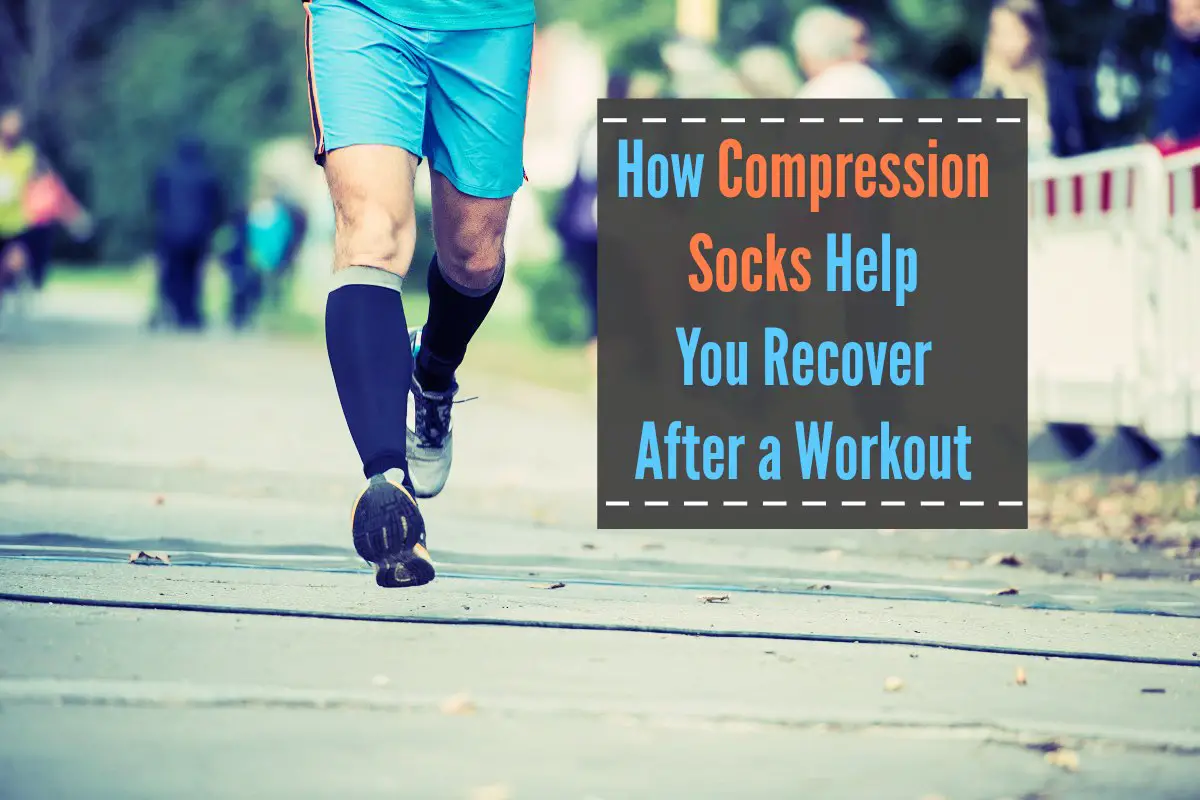Before you can understand why healthy, active, young people might want to consider using compression socks, you need to know exactly what compression socks can do to make recovery faster.
This type of sock fits very snuggly and usually comes up to the knee.
Once they are put on, they can assist in increasing blood circulation and reducing the build-up of lactic acid.
Some athletes wear compression clothing during their exercise routines, and others put them on after they have completed their workout.
Either way, the idea is that not only do compression socks help with circulation but they also fit better than traditional socks and reduce the chance of developing increased moisture on the feet and annoying folds or wrinkles in the socks that can result in rubs and blisters.
What Are Compression Socks?
Compression socks (Alternative names; Compression hose; Pressure stockings; Support stockings; Gradient stockings; Varicose veins – compression stockings; Venous insufficiency – compression stockings) are specially designed socks that compress the foot and leg in a graduated way to increase blood flow. (1)
In the past the socks were used mainly by people with vein problems.
The socks are made from a variety of stretchable and aerated materials, including spandex, polyester, nylon, and lycra.
Every fabric is chosen on the basis of what is needed to keep an athlete’s feet dry and healthy.
Types of Compression Stockings
According to Chung Sim Lim, MBBS PhD. there are three types of compression stockings: (2)
- Graduated or medical compression stockings (“Graduated compression stockings exert the greatest degree of compression at the ankle, and the level of compression gradually decreases up the garment“)
- Antiembolism stockings ( “the are used to reduce the risk of deep vein thrombosis, and also provide gradient compression”)
- Nonmedical support hosiery – including flight socks and elastic support stockings (“they have less compression than graduated compression stockings and the compression is uniform and not graduated”)
According to his review “graduated compression stockings are classified based on the compression pressure.”
The level of pressure is classified into several standards. Currently, there is absolutely no single standard used worldwide, which sometimes cause misunderstandings…
- Low compression – the pressure of less than 20 mm Hg
- Medium compression – pressure between 20–30 mm Hg
- High compression – pressure over 30 mm Hg
How Do They Help?
For the last few years, marathon runners have been using compression socks when they are training as well as when they are competing, according to Kim Bogin, from The Examiner.(3) In fact, runners have come up with some other reasons to give the socks a try.
Some athletes say the socks are terrific leg protectors when running outdoors.
They add that compression has been known to curb the amount of swelling in the legs after exercise.
Some share that the socks also warm the legs on those days when tights would contribute too much protection from the cold, but ankle socks would be too little.
The Efficacy of Compression Stockings
The efficacy of compression socks lies in their effects on blood circulation.
A good pair of compression socks can speed up recovery time after a workout. Blood transport oxygen to our muscles so better blood circulation will help our muscles to recover faster.(4,5)
According to Ajmol Ali 2011 study published in the Journal of strength and conditioning research, compression socks have no effect on performance, but, they help runners from losing muscular power.
It means that during the research race their leg muscles were less fatigued. This was on (12-15 mm Hg) and (18-21 mm Hg) pressure socks.(6)
A 2015 study, also published in the Journal of strength & conditioning research, showed that the participants who wore compression socks for two days (forty-eight hours) after the race, improved their post marathon treadmill performance.(7)
A strong stress activity such as downhill running causes weakness in the legs followed by muscle soreness.
Wearing compression socks for two or three days after an intense workout may help to ease this soreness and to decrease swelling around the legs.
And experts say that using something to increase athletic performance may, in and of itself, affect a person’s performance. Meaning if you think this change will be helpful, it probably will be.
Complications
Those in the know say that fitting the socks correctly is a must.
The person who will be wearing them will not get the compression benefits that are available if the socks are too loose, but if the socks fit too tightly they become impossible to don.
If complications occur, like your stockings feel too uncomfortable, or you have an allergy to stocking material, call your doctor/provider.
Conclusion
Overall, most exercisers who have tried wearing compression socks say they have found them to be comfortable and feel they are receiving benefits from adding the compression socks to their training gear.
A few even admitted that they felt cool when they were decked out in the fancy legwear.
It’s important to know that compression socks have to be sized by calf and ankle circumference.
Recommended pressure is 15-20 mm Hg.
References
(1)https://medlineplus.gov/ency/patientinstructions/000597.htm
(2)http://www.cmaj.ca/content/186/10/E391
(3)http://www.active.com/running/articles/5-reasons-to-wear-compression-sleeves-and-socks
(4)https://www.ncbi.nlm.nih.gov/pubmed/9578376
(5)https://www.ncbi.nlm.nih.gov/pubmed/11579174
(6)https://www.ncbi.nlm.nih.gov/pubmed/21293307
(7)http://journals.lww.com/nsca-jscr/Pages/ArticleViewer.aspx?year=2015&issue=02000&article=00030&type=Abstract
Leave Feedback: Was this article helpful?

